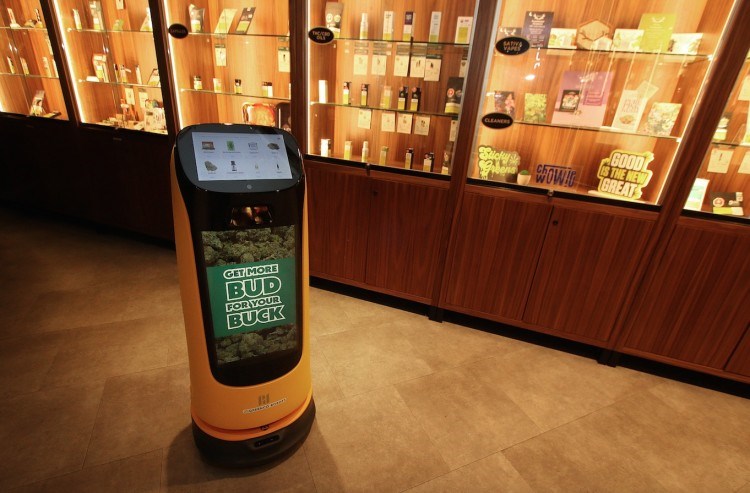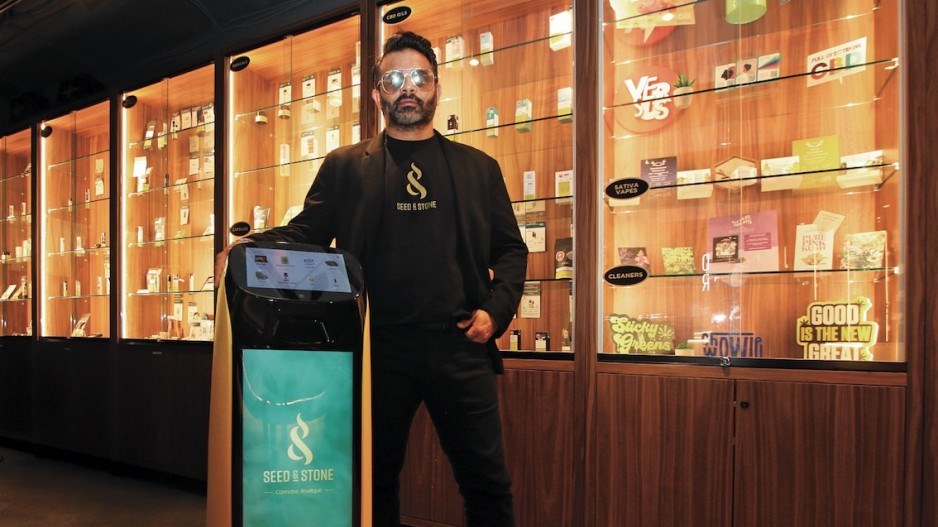Advances in robotics technology are making some retailers think about how they can integrate robots into their operations.
Vikram Sachdeva's six-location Seed and Stone cannabis store chain recently started using a robot from GreenCo Robots at his Delta location as part of a trial run. Sachdeva, CEO, said his intent is to have something to entertain customers when his store’s budtenders are busy ringing in sales or helping others.
“Once we see what the challenges are, and how we want to roll it out, we were thinking of putting a pamphlet or floor stand that says, ‘Say hi to ask him what you need,’” he said.
Sachdeva does not intend for the robot to replace his human staff. His robot has a screen that the customer can use to search, order and pay for products, but, by law, in-store cannabis products need to be provided by human beings, he said.
GreenCo’s CEO Liang Yu told BIV that dozens of B.C. restaurants are using his robots and that retail stores are also starting to see value in having them.
Vancouver-based Best Buy Canada has tested GreenCo’s robots at special events to help spread marketing messages about the event and help people find products.
"Customers could interact with the robot and select one of the seven experiences we had set up for the event, and the robot would lead them to each section before returning back to the front of the store to greet customers," Best Buy spokesman Mathew Wilson told BIV.
London Drugs sent BIV a statement saying that "for confidentiality reasons" the chain would not discuss "investments in technology related to robots in retail.”

(Image: The robot at Seed and Stone is intended to engage customers while budtenders are busy helping others | Rob Kruyt)
Yu said he also helps retailers by offering them robots that are designed to work in warehouses.
Those robots can reduce in size to get underneath pallets, and then rise to carry the pallets to desired locations.
They can also bring boxes of products to a human to pick one item in cases where the human would otherwise have to walk down aisles.
High-tech shopping carts are another form of robotic technology.
Sobeys (TSX:SBY) started testing what it called intelligent shopping carts in some Canadian stores in 2019.
Customers could place items in the cart, which would have a screen displaying a running tally of purchases. It also allowed customers to pay with their cart, thereby bypassing lineups.
Chinese retail giant JD.com is widely using robots that resemble shopping carts at its 7Fresh Markets.
Customers in China put on bracelets that communicate with the stand-alone shopping-cart robots.
“The cart follows you around the store,” said Kostya Polyakov, KPMG’s Canadian national industry leader in its consumer and retail practice.
“It can direct you to find the product that you wanted to buy. The cart is aware of promotions and sales. When you walk by something, it’ll pipe up, say, ‘Hey, this peanut butter is on sale.’ When you put something in the basket, it knows what you put in. At the end, you just walk out. You’ve paid for it.”
Save-On-Foods CEO Darrell Jones told BIV last year that his company did not adopt smart-shopping-cart technology in part because he was not convinced that weigh scales were accurate, and that he did not want customers to be incorrectly charged for items.
He added that customers were not requesting the technology.
BIV asked him in October whether his company is considering adopting robots for customers to use, and he said nothing is in the works.
“Robotics is something that we’re focused on in our warehousing and in places that aren’t customer facing,” he said.
“There’s some work being done on shopping carts, where you scan your groceries into the cart yourself – things like that. We’re looking at all those things, but in terms of robots actually doing things, no, I don’t think there’s anything out there now that would be financially viable for us.”
Christine Day, who was CEO at Lululemon Athletica Inc. (Nasdaq:LULU) for five years and previously headed Starbucks Corp.’s (Nasdaq:SBUX) Asian operations, now heads the sustainable clothing company House of LR&C.
She told BIV that robots cannot offer the insight and customer connection that knowledgeable salespeople can provide in fashion boutiques.
“I don’t think it ever replaces knowledgeable employees and engaging customer service,” she told BIV.
“People still crave a human connection. They want to know and be known. That’s part of the retail experience, and I don’t think that will ever go away.”
Day said the job of retail fashion store sales associates is increasingly to be “stylist influencers,” meaning that they will get to know what the customer’s style is and be able to recommend relevant clothing.
Robots could be used in retail to refill racks, execute cashier transactions and otherwise help the stylists, Day said.
“The job will be more rewarding when you’re the stylist-influencer in the store, compared with if you’re being just the person who rings up transactions or restocks.” •




